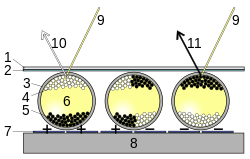
Back حبر إلكتروني Arabic ই-ইঙ্ক Bengali/Bangla E Ink Danish E-tint Estonian جوهر الکترونیکی Persian E Ink Finnish E Ink Galician E Ink Hungarian Digitale inkt Dutch E Ink Polish

| Legend | Item |
|---|---|
| 1 | Upper layer |
| 2 | Transparent electrode layer |
| 3 | Transparent micro-capsules |
| 4 | Positively charged white pigments |
| 5 | Negatively charged black pigments |
| 6 | Transparent oil |
| 7 | Electrode pixel layer |
| 8 | Bottom supporting layer |
| 9 | Light |
| 10 | White |
| 11 | Black |
E Ink (electronic ink) is a brand of electronic paper (e-paper) display technology commercialized by the E Ink Corporation, which was co-founded in 1997 by MIT undergraduates JD Albert and Barrett Comiskey, MIT Media Lab professor Joseph Jacobson, Jerome Rubin and Russ Wilcox.[1]
It is available in grayscale and color[2] and is used in mobile devices such as e-readers, digital signage, smartwatches, mobile phones, electronic shelf labels and architecture panels.[3]
- ^ Klein, Alec. "A New Printing Technology Sets Off a High-Stakes Race". The Wall Street Journal. ISSN 0099-9660. Archived from the original on 2015-12-08. Retrieved 2015-11-27.
- ^ Carmody, Tim (November 9, 2010). "How E Ink's Triton Color Displays Work, In E-Readers and Beyond". Wired. Archived from the original on November 12, 2010. Retrieved March 6, 2017.
- ^ "ePaper phones". www.e-ink-info.com. Archived from the original on 2019-01-09. Retrieved 2019-01-09.